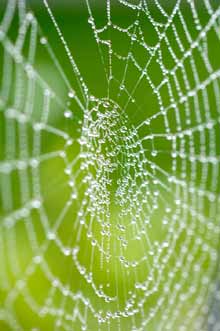|

June 24, 2008

You may have read several years back about goats genetically engineered to secrete spider silk proteins from their milk glands, the silk to be extracted, spun, and used to weave items such as lightweight bulletproof vests. Well, here’s an enthralling interview with Cheryl Hayashi, the University of California Riverside biologist who won a 2007 MacArthur Foundation “genius grant” to further her work with the evolution, genetics, and material properties of spider silk.
Her findings, already advancing our understanding of spider phylogenetics, also have the potential to influence the development of biomimetic material for a variety of applications, from biodegradable fishing lines to medical sutures to protective armor cloth. With a deep understanding of spider biology, Hayashi is contributing to a fundamental rethinking of arachnid phylogeny and revealing key information about spider silks to support the development of new synthetic materials.
Scientists are gaining on it, but they have yet to make silk as well as spiders do—natural dragline silk is five times as strong, by weight, as steel! And they have yet to “grow” spider silk in sufficient quantities to be practical or cost-effective:
To make a 5-pound bulletproof vest, a producer would use 600 gallons of goat milk containing the silk protein. The milk production from 200 goats in one day would be used for just one vest. . . . As a result, the [University of Wyoming] team is also considering introducing the silk gene into alfalfa.
Hayashi is now involved in the interdisciplinary effort to grow spider silk in transgenic crop plants – another likely candidate is tobacco! —which could yield much larger quantities at lower cost than goats or cows can. Hayashi’s awe of the handiwork of evolution, and her excitement about all that we latecomers can learn from it, is contagious:
Why do you want to make spider silk?
Spider silk, since it’s been evolving for hundreds of millions of years, that’s a lot of research and development already been done by nature. You want a material that’s very strong, that can withstand very high temperature? Let’s go study a desert spider. You want one that’s very strong that can actually absorb a lot of flying impact? Why don’t we study aerial web-weaving spiders? And it turns out that certain spider silks, by weight, are so much stronger and so much tougher than any other known natural or even man-made material.

Where do we stand with synthetic silk? Is it usable?
It’s been shown in the laboratory that it works, that we can make transgenic silk. Other labs have shown that they can spin it, but it’s all been done in small quantities. We’re not quite at the stage where we’re going to get an entire clothing line with spider silk, but I think it’s going to happen soon. . . .

What are the major challenges in making it?
Spinning the silk proteins turns out to be a really hard thing to do artificially. A lot of really high-tech, really smart labs are working on this. It’s a huge engineering problem to go from this liquid silk goo to a dry fiber that faithfully mimics all the fabulous properties of spider silk. I’m always just amazed that that little brown spider in the corner of my apartment is doing it.
More wonderful stuff: Here’s an overview of the uses humans have historically made of spider silk and the state of current research.
The alarm triggered by the creation of transgenic organisms ranges from the religious to the green. While their apocalyptic fears may be exaggerated—
Let your imagination run wild and you’ll be convinced as I am that the end of the world cannot be far away. . . . Will we see people with six legs like an insect? Will we see people that can climb trees like a cat? Will we see men with armor-plated skin like the armadillo? Will we see people that glow in the dark like fireflies? Don’t laugh; the frightening possibilities are endless.
—both sites are absolute treasure troves of links if you’re interested in reading more straight news stories on these subjects.
If you’re reading this, spiders probably don’t give you the creeps—but what about transgenic organisms? Do you think the benefits of mixing genes from different species outweigh the risks, or the other way around? Do you think these experiments can be safely regulated, or have we broken the latch on Pandora’s box?


(Annie Gottlieb) |
Comments (add yours!)

Return to June home
|


